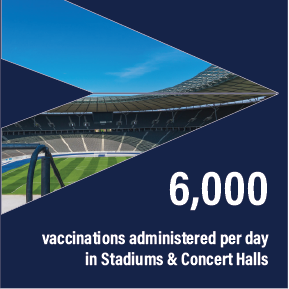<< Back to Media
FEMA Responds to COVID-19
May 25, 2021
On April 1, 1979, President Jimmy Carter signed Executive Order 12127 establishing the Federal Emergency Management Agency (FEMA). For 42 years, FEMA personnel have helped local, state, and tribal partners restore devastated areas following hurricanes, tornadoes, wildfires, and other natural disasters. FEMA employees and emergency management professionals are once again working to serve Americans by administering COVID-19 vaccines, dispersing funds for COVID-related funeral costs, and supplying personal protective equipment (PPE).
When Joe Biden assumed his position as President of the United States in January 2021, he announced the first and primary goal of his administration — vaccinate 100 million Americans within the first 100 days. With help from FEMA, this goal was surpassed in 58 days, 42 days prior to the 100-day deadline. Now, the United States is closing in on 200 million vaccine doses in the first 100 days, marking a new milestone in the fight against COVID-19. As of April 19, every American is now eligible for the vaccine — two weeks earlier than the initial May 1st deadline.
Leveraging the DPA and Stafford Act
The President has multiple regulatory levers they can use to direct federal departments, agencies, and private enterprises to channel their energy and focus during a time of national crisis. The Defense Production Act (DPA) is one of these unique devices. Enacted by Congress in 1950, in the wake of the Korean War, the DPA vests the Chief Executive with a wide range of economic powers to be used during a period of national crisis. These include increased production of critical products, supply management, export controls, and contract prioritization of defense-related goods and services. When the DPA was first written, it was narrowly applied to issues of defense and national security. But since then, the law has been expanded several times to include natural disasters and other national emergencies such as pandemics and epidemics.
The DPA intentionally conveys broad executive authority, and the President, who invokes it, can decide how it is implemented. In 2020, President Trump invoked the DPA to bolster the export of medical goods, increase domestic production of PPE, and secure the American food supply. On his first day in office, President Biden signed Executive Order 14001, once again invoking the DPA. Executive Order 14001 also activated Sections 306 and 307 of the Robert T. Stafford Disaster Relief and Emergency Assistance Act, authorizing the FEMA Administrator to rely upon the local, state, and tribal workforce, and hire a large swath of temporary employees if necessary. While his invocation had elements similar to President Trump’s order, President Biden focused primarily on equipping vaccine manufacturers with the supplies and equipment they need to mass produce, enabling the administration to meet its vaccine goals. By taking these actions and implementing the statutes within the DPA, FEMA has been empowered to administer millions of doses of the COVID-19 vaccine.
In partnership with local, state, and tribal partners, FEMA is working tirelessly to erect mass vaccination sites across the United States. FEMA’s Interagency Vaccination Task Force has deployed FEMA staff to various sites, and these staff members are working in conjunction with personnel from the National Guard and Coast Guard.

Shots in Arms
By relying on census data and the Centers for Disease Control and Prevention’s (CDC) social vulnerability index, FEMA is also making every effort to ensure the vaccine distribution is equitable. Vaccinating individuals with comorbidities, minorities, elderly people, and other vulnerable members of the American population is vital to stopping the spread of COVID-19. Considering additional variables such as geographic location, patient age, and socio-economic status will create safeguards against undue burdens that may hinder wider vaccination efforts.
To ensure all the variables are evaluated equally, FEMA created a multi-tiered blueprint for vaccination clinics and sites, each of which carry their own benefit for a specific segment of society. For example, a centrally located stadium in a dense neighborhood may alleviate concerns regarding lack of transportation. A mobile, transportable vaccine center may service remote locations, or come directly to those with stringent work or childcare responsibilities. Drive-thru clinics provide a quick and simple option for those who may show low vaccine confidence, or do not have access to reliable health service providers.
- Type 1: Stadiums, Concert Halls, etc. (6,000 vaccinations per day)
- Type 2: Hospitals, Health Clinics, County Health Departments, etc. (3,000 vaccinations per day)
- Type 3: Schools, Community Centers, etc. (1,000 vaccinations per day)
- Type 4: Churches, Drive-Thru Clinics (250 vaccinations per day)
- Type 5: Mobile Community Vaccine Centers (~250 vaccinations per day)

During the COVID-19 pandemic, the capabilities of the Department of Homeland Security and FEMA have been on full display. In the 42 years since the founding of FEMA, there have been many disasters that Americans have faced together. One could make the argument that COVID-19 is our most acute and pervasive challenge yet. But soon, with the help of FEMA, every person in America will have an opportunity to receive a COVID-19 vaccination, marking a crucial first step towards normalcy.
At WBD, we are proud to help FEMA serve the American public, and we look forward to our continued relationship.
…
Author: Jackson Stuteville, Associate at WBD, is a Policy and Governance professional engaged with the Department of Homeland Security (DHS) and the Federal Emergency Management Agency (FEMA).
